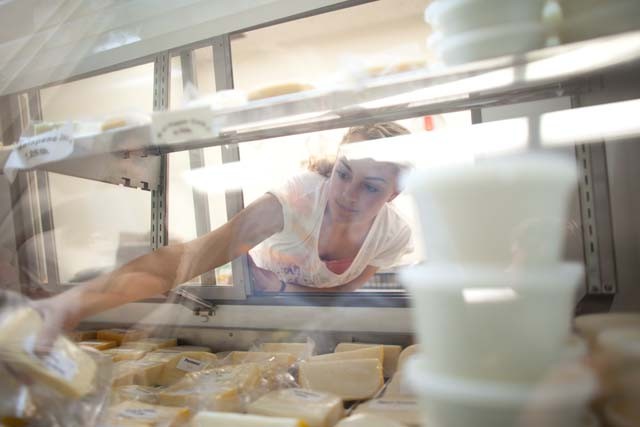During World War II, Minnesota was named the bleu cheese capitol of the world, in part because of the University of MinnesotaâÄôs dairy industry.
Today, the UniversityâÄôs cheese making doesnâÄôt reach as far, but many say the products at the Food Science and Nutrition Dairy Salesroom are better than what they find in grocery stores.
Housed in the Andrew Boss Laboratory of Meat Science, the store is open every Wednesday afternoon except for holidays. But things may change in the future.
A survey ended Wednesday that allowed customers to mark their preferred day if the store were to expand its hours. Jodi Nelson, a senior laboratory services coordinator, said it is unclear what will be done with the results.
Every week there is a line to get into the store before it opens. Depending on the weather, the store can see 200 to 300 people a week.
Some customers stop in for a snack âÄî like a pint of ice cream between classes âÄî while others incorporate it into their weekly errands.
Jerry Koplos, a frequent customer and retired University maintenance worker, said his mom used to come on a regular basis and, after her death, he took over.
He couples his visit to the dairy salesroom with a stop downstairs to buy some meat from the UniversityâÄôs meat lab.
âÄúItâÄôs always a surprise to see what they have,âÄù Koplos said. âÄúThey donâÄôt have the same stuff every time.âÄù
The products are made in the Joseph J. Warthesen Food Processing Center, a multi-level, multi-room structure that houses new and old, manual and automatic food processing equipment.
One of the larger and newer pieces of equipment Nelson calls âÄúthe elephant.âÄù The enclosed vat structure is run by a computer, an industry standard.
âÄúWhen the company put this in they had some really high expectations of it being able to work,âÄù Nelson said. âÄúItâÄôs not really useful to us that often … they learned a lot from it and we donâÄôt use it too often.âÄù
Today, the products sold in the store are made a building away, far from the caves in St. Paul.
The caves were once sand mines, but were transformed into mushroom growing caves in the early 20th century. In the 1930s, Professor Willes Barnes Combs discovered the caves while shopping for mushrooms, and realized they were similar to French caves where Roquefort cheese is made, wrote Greg Brick, a Ph.D. candidate and author of âÄúSubterranean Twin Cities.âÄù
The last use of the University cheese caves was by graduate students in the 1950s. Now the caves sit in ruins because of Mississippi River flooding.
Nelson said that when she was at the University as an undergraduate, her professor told her about the caves.
The only trace that remains of the old ways is the nickname she has given the refrigerators that are used to house the bleu cheese while it ferments.
To the groups of school children that tour the Pilot Plant, the room is the âÄústinky room,âÄù because of the brine solution that makes some of the cheese.
The milk comes in from the dairy barn the day before the process. Products are made once or twice a month between classes and outreach.
Outside companies can rent the space to test out products, which is often more convenient than using their own facilities because they can make smaller batches and do not have to stop production on their own machines.
Products in the store vary. Ice cream flavors change depending on the season. Some specialty cheeses are made when visiting companies have excess milk, and yogurt is sometimes available from classes.
The cheeses tend to be more artisan than production. Made from hand, cheeses are held anywhere from 90 days to longer than a year âÄî aged cheddar is held for more than 9 months.
When the products are finished, they are stored in âÄúCave 2,âÄù a locked refrigerator filled will all varieties of cheese. Students, typically within the food science and nutrition department, help run the store and keep it stocked.
Elisabeth Taraldsen and Amanda Bot have worked at the store and in the Pilot Plant for one and two years, respectively.
They help make the products, clean and answer customer questions.
Bot said she also considers herself a promoter.
âÄúI like to come up with new flavors, but our supervisors donâÄôt usually take them too seriously,âÄù Bot said.
She has been hoping for a sâÄômores ice cream, while Taraldsen has proposed carrot cake.








